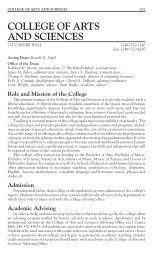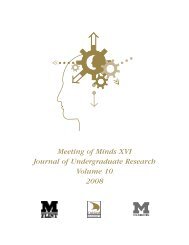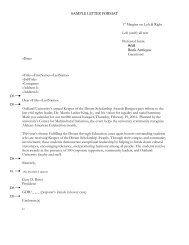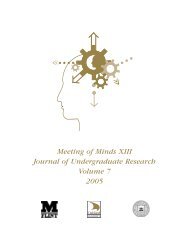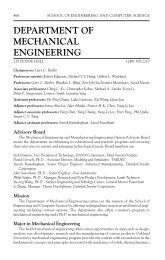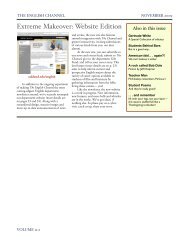MOM 2006 journal for pdf.pmd - University of Michigan-Flint
MOM 2006 journal for pdf.pmd - University of Michigan-Flint
MOM 2006 journal for pdf.pmd - University of Michigan-Flint
Create successful ePaper yourself
Turn your PDF publications into a flip-book with our unique Google optimized e-Paper software.
It is difficult <strong>for</strong> many critics, as it is <strong>for</strong> myself, to confront this question without connecting<br />
Bishop’s “driving to the interior” <strong>of</strong> the South American continent, to the journey <strong>of</strong> Joseph<br />
Conrad’s Marlow into the interior <strong>of</strong> Africa. Knowledge <strong>for</strong> Conrad is gained by moving toward<br />
the center <strong>of</strong> a country, yet Bishop’s suggestion <strong>of</strong> the same is put into question by the entire<br />
poem which precedes it.<br />
“Arrival at Santos,” like its speaker, is in constant movement; the speaker’s eye flits from the<br />
water to the mountaintops, from building to building. Her attention then snaps suddenly, as if by<br />
<strong>for</strong>ce, to entirely different topics. This is unusual <strong>for</strong> Bishop who is best known <strong>for</strong> the eye that<br />
is “looking outside, inside, and around its subjects with an adroitly realized complexity <strong>of</strong><br />
perspective” (Travisano, Mid-century Quartet 58). The speaker seems to want this depth since<br />
she grasps <strong>for</strong> detail at every possible chance: “Here, after a meager diet <strong>of</strong> horizon, is some<br />
scenery: / Impractically shaped and—who knows?—self-pitying mountains, / Sad and harsh<br />
beneath their frivolous greenery” (2-4). As Cleghorn points out, it is as if “the poet is saying,<br />
‘yes, those mountains could have emotions <strong>for</strong> all I know, as ridiculous as such a pathetic fallacy<br />
may be.’” The attempts at insight are dismissed as “immodest demands” <strong>for</strong> immediate and<br />
“complete comprehension” (9-10).<br />
As the poem progresses, the speaker lingers the most on those aspects <strong>of</strong> the location she has<br />
had a longer amount <strong>of</strong> time to observe. For example, the speaker delivers an unusual amount <strong>of</strong><br />
the short poem to Miss Breen, who she would have gotten to know on the eighteen-day boat trip<br />
(20-29). Breen’s character is so thoroughly developed that she may have made a good subject <strong>for</strong><br />
the entire poem, yet her details are broken <strong>of</strong>f by the physical movement toward Customs. As<br />
long as the speaker keeps being interrupted she doesn’t have a chance to know anything about<br />
Santos, but the potential is undeniably present. Jeffrey Grey sees the poem this way:<br />
One is trapped in a bay, and the promise <strong>of</strong> access to an “interior”—always a pun in travel<br />
writing, since voyages are notoriously journeys to discover oneself—is withheld.<br />
If the interior is the journey “to discover oneself,” who is to say this act <strong>of</strong> self-discovery couldn’t<br />
have occurred in the <strong>for</strong>eign land <strong>of</strong> Santos just as well as anywhere else? I would argue the<br />
speaker <strong>of</strong> “Arrival at Santos” is not plagued by “being trapped in a bay,” but instead troubled by<br />
her rushed departure from it. Santos might have had the same role as the interior the speaker<br />
heads <strong>of</strong>f toward if the stay not been so short. It seems Bishop’s interior is not geographical, but<br />
a heightened state <strong>of</strong> understanding.<br />
The tentative assessments scattered through “Questions <strong>of</strong> Travel” caution against claiming to<br />
know anything that does not belong to the interior. The poems that follow still address unfamiliar<br />
objects and people, but they do so with full awareness <strong>of</strong> a tourist’s perspective. This poem<br />
provides a cautionary tenet <strong>for</strong> the author and reader to not make assumptions about unknown<br />
environments.<br />
The Risk to the Observed<br />
“Brazil, January 1, 1502” is a sharp departure from the lightness in the two poems surrounding<br />
it. Immediately the poem is introduced in context <strong>of</strong> the two sets <strong>of</strong> visitors to a Brazilian <strong>for</strong>est:<br />
our 20 th century tourist, and the 16 th century Portuguese settlers. The perspective <strong>of</strong> the<br />
Meeting <strong>of</strong> Minds <strong>2006</strong> 47



